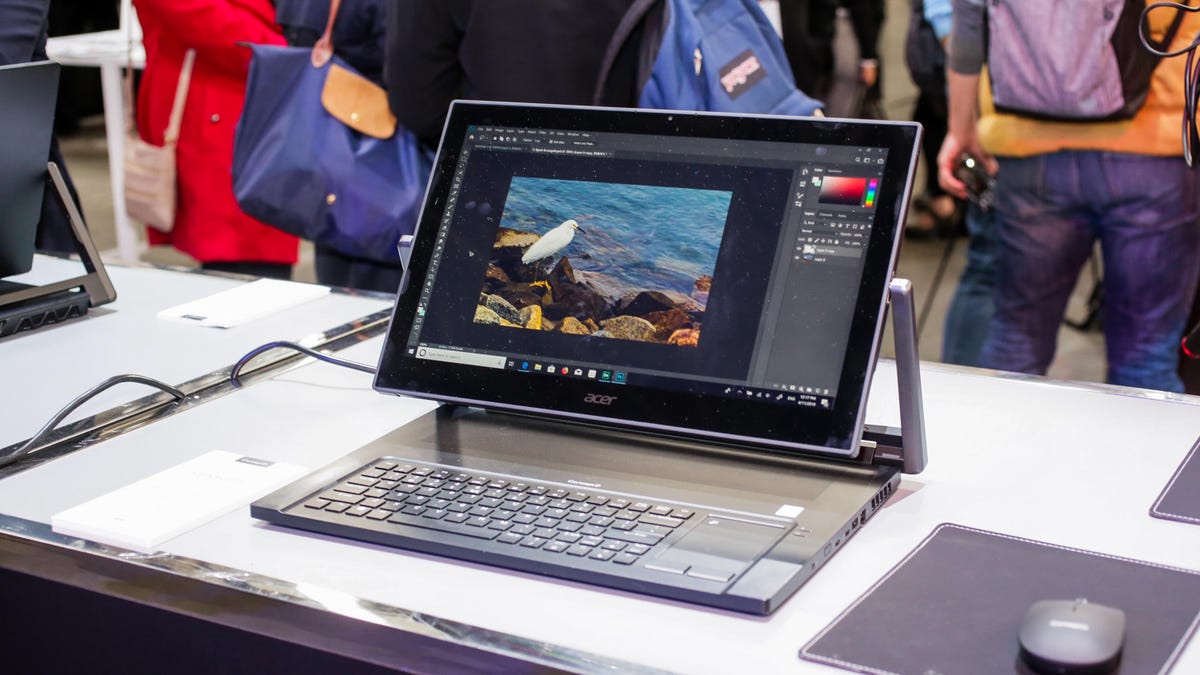
Acer Concept D 9
The Predator Triton 900 reworked with a 4K, wide color Wacom EMR-compatible display, the Ezel rotating screen works much better here and for artistic applications than it ever would for gaming.
Back
You can always tell a gaming laptop by the back and its macho grillework. What's nice is that there are connections back there, in this case HDMI and power, so the cables stay out of the way.
Still black
Interestingly, Acer didn't dip the 9 in white.
Cooling
The design of the 9 allows for a lot more venting as well, which helps keep the hot-running CPU and GPU from bursting into flames.
Wacom EMR stylus
Wacom EMR (electro-magnetic resonance) is its professional-level pressure-sensitivity technology. The stylus charges via the screen, so no batteries are required, and it supports 4,096 levels of pressure (8,192 in Wacom's own products).
Pressure
The engineering sample didn't have the screen set up properly -- I don't think the Wacom driver was installed -- so we couldn't try the pressure feel. The nib felt a little too rubbery, though.
Multiangle screen
The tilting, flipping screen can sit at almost any angle, from almost flat to almost vertical, which is ideal.
The Ezel in action
Flip.
The Ezel in action
Flip.
The Ezel in action
Flip. (With Windows set up properly, the screen will rotate when it's in this position.)
Glossy display
I'm not crazy about the reflective display or big bezels, but that's a technological problem, not a design problem.
Ugh.
This is where the conversion from a gaming notebook doesn't work so well. An icky gaming touchpad in a weird spot (though people have told me they like the location after they get used to it) and a mushy keyboard. I hope that's because it was an engineering sample.
Connections
On the right side you've got USB-C/Thunderbolt, USB-C with alt mode for an external monitor, a USB-A and Ethernet.
Connections
On the left side are two USB-A ports and headphone and mic jacks.
Acer Concept D 500
Acer went experimental for the design of its midrange workstation, so props for that, but I think looks a bit like this litterbox.
Matching system
The line has matching white accessories, which neither delight nor dismay.
Top connections
It's got three USB-A and one USB-C, plus headphone and mic jacks, an SD card slot and a Qi wireless charger on top.
Faux-wood accent
You'll never mistake this for real wood.
Headset hook
Acer's used this before, but it's a nice touch.
Acer Concept D 500
I wonder if it blocks airflow when a headset's dangling on the hook.
Grille
Right side
The whole thing's practically ventilation.
Back
Maxxed out with a Quadro RTX card, you're going to lose half your slots.
Faux wood redux
Acer Concept D 900
This is the big kahuna of the Concept D line, an imposing but relatively conventional black tower.
A couple of ports
Since this system is intended to be neither seen nor heard, it doesn't need a lot of connections up front.
Back
There's tons of space inside, but this is not a case l'd like to get into. It may be toolless on the inside (we don't know), but it's pretty old-fashioned on the outside.
Deep
At over 2 feet deep, it's a lot bigger than it looks from up front.
Acer Concept D 5
The lowest-end laptop uses the Intel i7-8705G or i5-8305G CPUs with AMD RX Vega M GL graphics. It's based heavily on the Aspire 7, but with a 4K 100% Adobe RGB display.
Acer Concept D 5
It looks like a typical mainstream thin clamshell, but white.
Mouse
OK.
Acer Concept D 5
Simply making the keys white doesn't always work. The labels may turn out to be too low-contrast for some, especially if the backlight is white. (I forgot to check that.)
Fingerprint reader
Thin!
Left side
Ports on the left side include HDMI, two USB-A, a USB-C and a headphone jack.
Right side
A USB-A connection and handy SD card slot live here.
Acer Concept D 7
The midrange laptop is based on the Predator Triton 500 gaming system. Chamfers and bevels are big in premium laptop design these days, but I'm not sure it works for me in white.
Keyboard
It has a more conventional version of the Triton 500 keyboard, without the specially reinforced and highlighted keys used in gaming (e.g., WASD). It also doesn't have the Turbo button that lets you overclock the GPU.
Left side
You've got Ethernet, one USB-A and an HDMI port, plus headphone and mic jacks.
That gaming grille
Right side
Two USB-A, a USB-C/Thunderbolt and a Mini DisplayPort connector sit on the right side. I wonder if it supports G-Sync via the Mini DisplayPort.
Pantone Validated
This means a lot less than you might think, unless you think it means it's good at matching spot colors in the Pantone Matching System.
Monitors
Acer announced two new monitors, which visually look like the Predators; they do have those matching faux-wood bases, though. The CM7321K is a 32-inch, 4K DisplayHDR 1000 display using mini-LED technology to provide over 1,100 local-dimming zones, covering 90% of Rec 2020 (but notably, with no claims about accuracy).
The second monitor, the CP7271K, is 27-inch 4K with a 144Hz refresh rate and G-sync Ultimate -- what used to be called G-Sync HDR -- with that standard's fast refresh rates and 1,000-nit peak brightness. This one does claim color accuracy and 100% Adobe RGB coverage.
Swivel
I do like -- in theory -- this lock that lets you easily know how to position it correctly after swiveling. At least, I think that's what it's for.
Acer Concept D Ojo VR headset
Acer updated and rebranded its Windows Mixed Reality Headset with Inside Out tracking. Like other companies, it seems to be downplaying the WMR connection.



